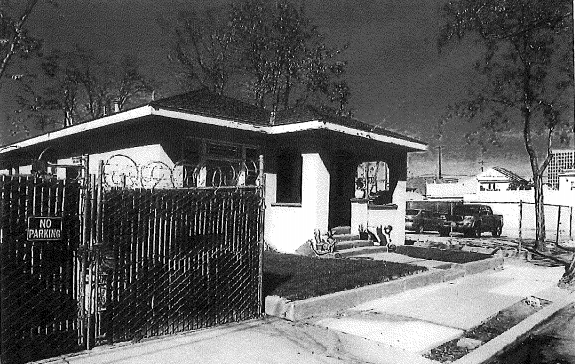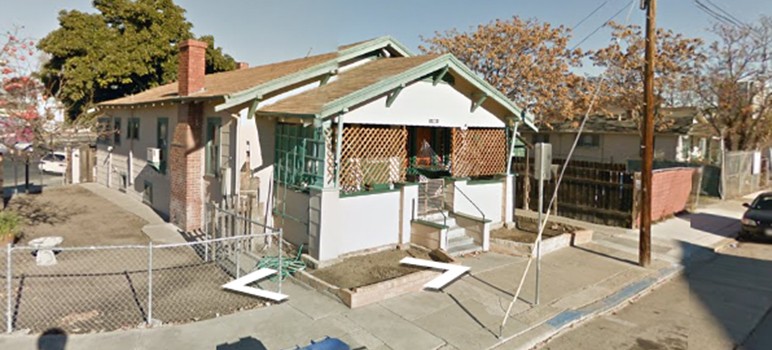An old yellow cottage in Delmas Park has become a point of contention in a debate about the future of downtown San Jose.
When Dean Hanson bought the 96-year-old single-story home at the corner of Lorraine Avenue and Montgomery Street, he had a vision of replacing it with a six-story apartment. The 5,000-square-foot corner lot lies in the thick of a blighted neighborhood north of I-280 and west of Highway 87, ostensibly ideal for the kind of dense development Hanson proposed.
Shortly after acquiring the house this spring for $450,000, he asked the city to rezone the parcel from light industrial to commercial, which would allow for housing and ground-floor retail. The request comes up for consideration at Tuesday’s City Council meeting.
But the tight-knit community of 1,000 residents soundly opposed the plan pitched by an out-of-towner (Hanson lives in Folsom). First of all, it would add no new parking in an already car-crowded corner of town, residents argue. And second, they say, it would continue the practice of splitting up the neighborhood through scattershot parcel-by-parcel development.

A home next-door to a razor-wire-fenced body shop on Lorraine Avenue, where incompatible zoning has led to a proliferation of unlikely neighbors. (Photo by Phil Hood)
In the 1950s, the city opened up the neighborhood, which once consisted entirely of single-family homes, to industrial uses. The result: a hodgepodge cluster of homes sidled alongside smog stations, warehouses and concertina wire-encircled auto body shops.
“The proposed development which accompanies this request for rezoning echoes the mistakes of the 1950s,” Delmas Park resident Phil Hood wrote to the city, protesting Hanson’s plan. “If you allow the development by fight of a six-story building on a .10 of an acre lot on a street lined with single-story homes without a comprehensive look at the surrounding area and no guarantee that development will integrate with anything else—history will likely repeat itself."
Hanson’s potential micro-development also complicates matters for a family that spent the past four decades buying up the bulk of the neighborhood.
Nick D’Arpino began working at S&S Welding in 1959, bought the business in 1970 and proceeded to collect property around it. The D’Arpinos now own 81 percent of Delmas Park—26 parcels in all. They’re holding out for the city to implement its Diridon Station Area Plan, an ambitious blueprint to transform 250 acres of downtown into dense, public transit-friendly hub of housing, industry, retail, entertainment and, just maybe, a new A’s stadium.
“When fully developed the Diridon Station Area will be the economic engine of San Jose,” Ron Biagini, the D’Arpino family lawyer, wrote to the city. “It will be a premier urban village second to none anywhere in the country. How extraordinary is the opportunity before us to redevelop five acres of land within the Diridon Station Station Area on a fresh, clean pallet?”
While Hanson’s plans fit in with conventional city zoning, they fly in the face of the D’Arpino family’s efforts to pave the way for cohesive development, like a destination with hotels, shopping centers, town homes and public spaces, Biagini continued.
“In the past few months, in talking to council members and planning staff, it has become clear that there are policies in place to support and promote infill development of small paresis of less than 10,000 square feet,” he wrote. “But these same polices also make it visually impossible for private assemblers, like the D’Arpinos, to finish their task.”
Deanna Libert, also part of the D’Arpino family, said she worries that approving Hanson’s rezoning request would set a risky precedent, allowing other micro-developments to build away without any parking accommodations.
Hanson reminded the planning commission in earlier meetings that the D’Arpinio family could have bought the house at 565 Lorraine Ave. when it was on the market this March, but did not.
Downtown Councilman Sam Liccardo isn’t too keen on Hanson’s vision for the site. But, he acknowledged, the property owner is incentivized to pursue piecemeal development by the city’s own rules, which allow projects on less than 10,000 square feet to provide no parking. The city’s trying to change that.
“With the adoption of the Diridon Station Area Plan, the council has explicitly directed that we untangle these incompatible uses and work to create a more integrated, consistent urban design, in part, by incentivizing consolidation of parcels,” Liccardo wrote in a memo.
Planning commissioners already denied the rezoning request. It’s up to the council to make a final decision.
More from the San Jose City Council agenda for August 19, 2014:
- The council will consider spending $975,000 on consultants over the next few years to help recruit more airlines for the Mineta San Jose International Airport.
- Now that the city adopted a new set of cannabis club regulations, it came up with a list of suggested bail amounts for misdemeanor code violations.
- Fixing and coating five clarifier tanks at the San Jose-Santa Clara Regional Wastewater Facility will cost $638,513. Clarifier tanks are used to separate biomass solids from liquid, leaving clean water for the recycled water service district.
- A property manager at the airport can make up to $127,000 a year. The pay classification is one of several being updated by the city’s personnel office.
- Councilman Johnny Khamis and an entourage of city staff will visit Copenhagen, dubbed the "City of Cyclists." The Knight Foundation will pick up the $3,500-per-person tab for the junket, which is supposed to give city leaders some ideas for how to make San Jose a more livable, walkable and bike-able place.
- A surge of leaky pipes forced the city to bump up payments to the privately owned San Jose Water Company by $450,000, bringing the grand total to more than $2.6 million.
- A $2 million federal grant will help San Jose, Gilroy, Mountain View and Santa Clara County fire agencies buy new handheld radios.
WHAT: City Council meets
WHEN: 1:30pm Tuesday
WHERE: City Hall, 200 E. Santa Clara St., San Jose
INFO: City Clerk, 408.535.1260


> •A $2 million federal grant will help San Jose, Gilroy, Mountain View and Santa Clara County fire agencies buy new handheld radios.
Just asking.
Why did we send the $2 million bucks to the feds in the first place, and then bow and scrape to Harry Reid, John Boehner, Barack Obama, and that twerpy little press spokesman to get OUR money back to benefit OUR community?
The grinning and smarmy Barbara Boxer, Dianne Feinstein, Mike Honda, and Zoe Lofgren fantasize that “THEY got the money for us”.
The reality is that we probably sent $102 million to Washington to get our lousy $2 million, and rest of the money probably went to Cowboy Poetry Museums in Nevada, BLM “Free Speech Zones” near Veterans Memorials in Washington D.C., and Homeland Security ammo reserves . . . EVERYWHERE.
It’s true. Places in the South do much better than us.
http://www.huffingtonpost.com/2014/03/26/republican-states-most-dependent-government_n_5035877.html
> It’s true. Places in the South do much better than us.
HuffPo is talking about the Crony Capitalist GOP. They are now just captive milk cows on the Big Government Farm.
Big Government buys gazillions of dollars of stuff from Crony Capitilsts. The Crony’s like it that way. They give BIG, BIG, BIG campaign donations to people who promise endless stimulus programs that goose up government procurement.
Ever hear of Daddy Warbucks?
In case you haven’t noticed, the GOP is splitting up into the libertarian, Tea-Party, free-market, grass roots GOP, and the Carl Rove don’t-be-a-scary-extremist-go-along-to-get-along “efficient” big government GOP.
The reason the south, in particular, receives more government dollars than it sends to Washington is progressive taxation. Incomes are higher in California and Connecticut, two blue states. Institute a flat tax, and taxes will go up in red states and down in blue states.
A. Incomes are higher in California because it is one of the urban vote plantations that have been crammed with stimulus spending.
B. I’m for a (lower) flat tax.
Be relevant next time.
This is downtown in California’s 3rd largest city, probably not the place to live if you don’t like tall buildings and sparse parking.
“•A $2 million federal grant will help San Jose, Gilroy, Mountain View and Santa Clara County fire agencies buy new handheld radios.” SO, just how many handheld radios do you get these days for $2million?
Probably just a couple of hundred.
> In case you haven’t noticed, the GOP is splitting up into the libertarian, Tea-Party, free-market, grass roots GOP, and the Carl Rove don’t-be-a-scary-extremist-go-along-to-get-along “efficient” big government GOP.
By the way, just to keep things equal and fair, the Democrats seem to be on track for a messy and bare-knuckle split of their own between the Obamunists and the Clintonistas.
Hard looks. Name calling. Fist fights. Knee capping. Kicking for the groin.
Billy Bubb has already accused Obama of “playing the race card on me.” Clinton can bite his lip when he needs to, but Clintons never forget.
Coming to a Democrat caucus near you.
Scott Herhold must subscribe to this.